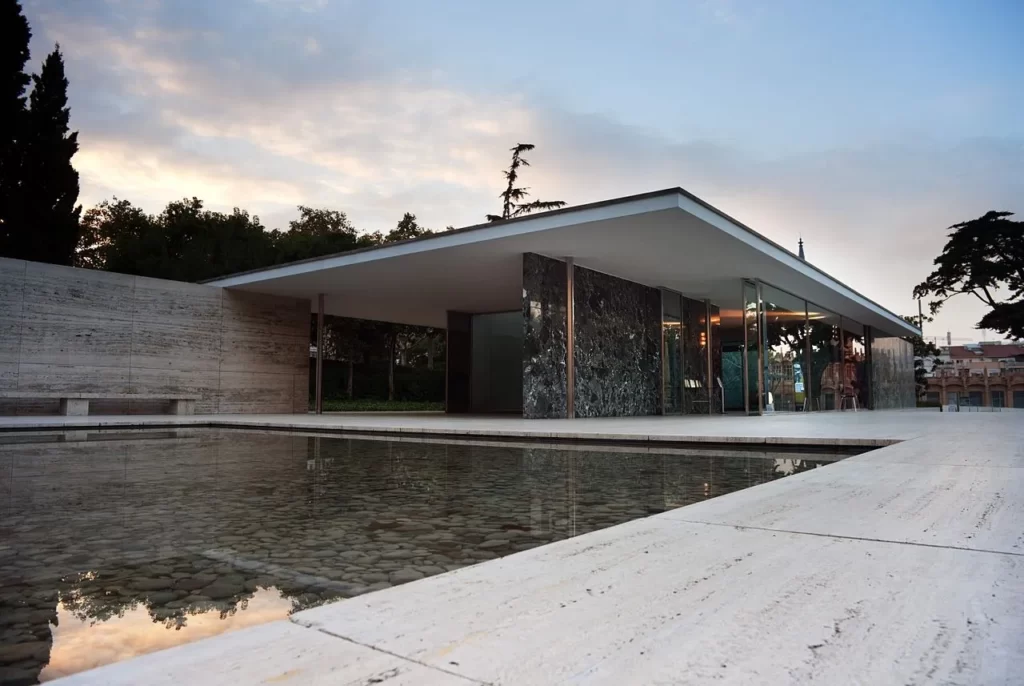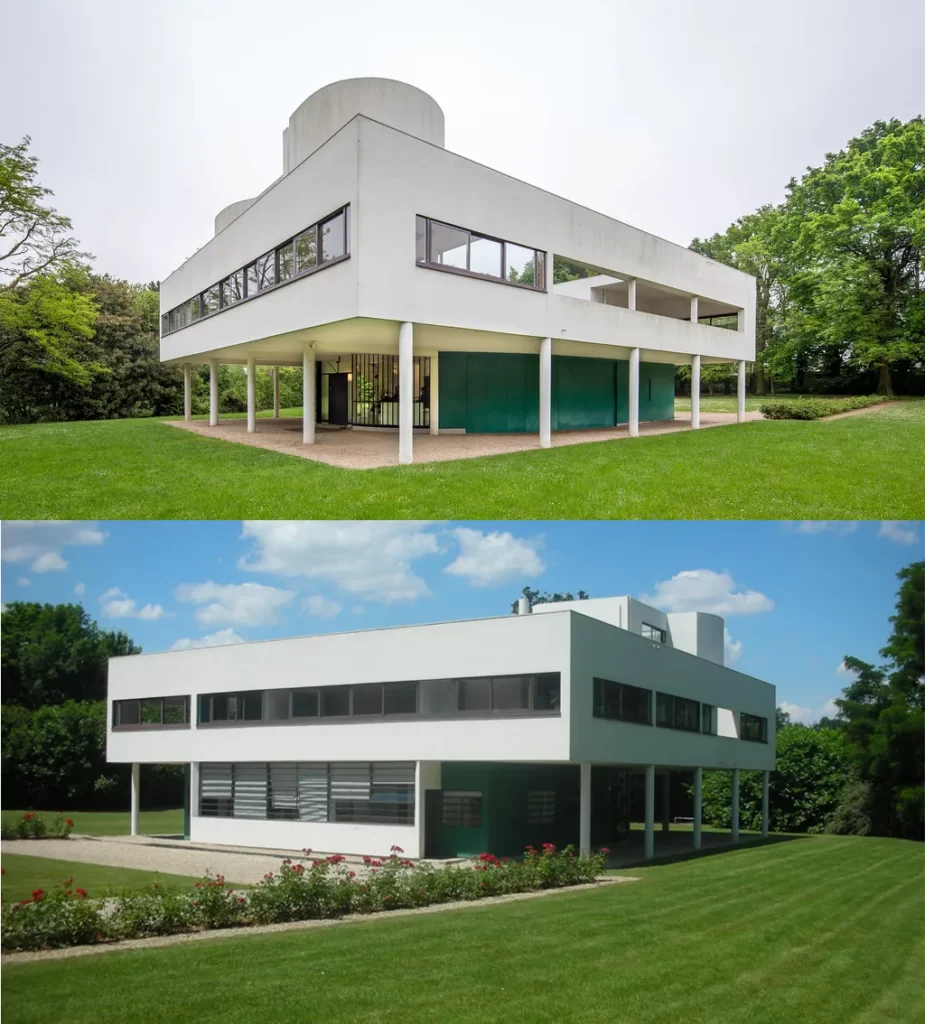If you want to know about the classical-architecture or staircase design or landscape garden, please click the link.
Introduction
The Bauhaus Movement in architecture was a German design movement that emerged in the early 20th century, which emphasized functionalism, simplicity, and the integration of art and technology in architecture and design.

Historical context of the movement
The Bauhaus Movement was founded by Walter Gropius in 1919 in Weimar, Germany, following the end of World War I. At the time, Germany was facing social, economic, and political upheaval, and many artists, designers, and architects were seeking new ways to create a better society through art and design.
Gropius established the Bauhaus school as a response to this need, with the aim of combining art, craft, and technology to create functional and affordable design for the masses.
Importance of the movement in the history of architecture
The Bauhaus Movement played a significant role in the development of modern architecture and design. Its emphasis on functionality, minimalism, and the use of modern materials and techniques influenced a generation of architects and designers who sought to create a new aesthetic for the modern age.
The Bauhaus school also served as a hub of artistic experimentation and collaboration, bringing together artists, designers, and architects from various disciplines and nationalities.
Today, the legacy of the Bauhaus Movement continues to inspire designers and architects around the world, who strive to create innovative and sustainable design solutions that reflect the principles of the movement.
1) Key characteristics of Bauhaus Movement in Architecture
Focus on functionality and simplicity:
The Bauhaus Movement emphasized the importance of functionalism and simplicity in design. Buildings and objects were to be designed with their intended purpose in mind, and unnecessary ornamentation was to be avoided. The aim was to create designs that were practical, efficient, and accessible to the masses.
Use of modern materials and techniques:
The Bauhaus Movement also stressed the importance of using modern materials and techniques in design. Advances in technology and manufacturing allowed for the creation of new materials such as glass, steel, and concrete, which were used extensively in Bauhaus architecture.
The movement also encouraged the use of industrial production methods to create affordable and mass-produced design objects.
Minimalist design with clean lines and geometric shapes:
Bauhaus architecture is characterized by its minimalist design, with clean lines and geometric shapes. Rectangular forms, flat roofs, and large expanses of glass are common features of Bauhaus buildings. The movement also favored a limited color palette, with an emphasis on black, white, and primary colors.
Integration of art, craft, and technology:
Finally, the Bauhaus Movement emphasized the integration of art, craft, and technology in design. The aim was to bring together different disciplines and create a new type of design that would be accessible to all.
Bauhaus architecture often featured decorative elements that were designed to be functional, such as metalwork or lighting fixtures that were integrated into the building’s structure.
The movement also encouraged artists and designers to work collaboratively to create new and innovative designs.
2) Founders and key figures of the Bauhaus Movement in Architecture
Walter Gropius, founder of the Bauhaus school:
Walter Gropius was a German architect and designer who founded the Bauhaus school in 1919. He was an influential figure in the development of modern architecture and design, and his vision for the Bauhaus school was to create a new type of art and design education that combined art, craft, and technology.
Under his leadership, the Bauhaus school became a hub of experimentation and collaboration, bringing together artists, designers, and architects from various disciplines.
Mies van der Rohe, director of the Bauhaus school:
Ludwig Mies van der Rohe was a German-American architect and designer who served as the last director of the Bauhaus school. He was a prominent figure in the development of modern architecture, and his designs emphasized simplicity, functionality, and the use of modern materials such as glass and steel.
Mies van der Rohe’s designs for buildings such as the Barcelona Pavilion and the Farnsworth House are considered iconic examples of modernist architecture.
Le Corbusier, Swiss architect and designer who was influenced by the Bauhaus Movement:
Le Corbusier was a Swiss-French architect and designer who was influenced by the Bauhaus Movement. He was a prominent figure in the development of modern architecture, and his designs emphasized functionality, efficiency, and the use of modern materials such as reinforced concrete.
Le Corbusier’s designs for buildings such as the Villa Savoye and the Unité d’Habitation are considered landmarks of modernist architecture, and his ideas on urban planning and design have had a significant influence on the development of modern cities.
3) Evolution of Bauhaus architecture
The early years of the Bauhaus school and its influence on modern architecture:
In its early years, the Bauhaus school in Weimar, Germany, was focused on art and design education, with an emphasis on the integration of art, craft, and technology. Students were encouraged to experiment with different materials and techniques, and to collaborate with each other on projects.
The early Bauhaus style was characterized by geometric forms, primary colors, and a focus on functionalism and simplicity. The school’s philosophy had a significant influence on the development of modern architecture, and many Bauhaus graduates went on to become influential architects and designers in their own right.
The impact of the Bauhaus Movement on the International Style:
The Bauhaus Movement had a significant impact on the development of the International Style of architecture, which emerged in the 1920s and 1930s. The International Style was characterized by functionalism, minimalism, and the use of modern materials such as glass, steel, and concrete.
Many of the architects associated with the International Style, such as Le Corbusier and Mies van der Rohe, were influenced by the ideas and philosophy of the Bauhaus Movement, and incorporated its principles into their own designs.
The International Style became an important movement in modern architecture, and its influence can be seen in buildings all over the world.
The legacy of Bauhaus architecture in contemporary design:
The legacy of Bauhaus architecture can still be seen in contemporary design today. The movement’s emphasis on functionality, simplicity, and the integration of art, craft, and technology continues to inspire designers and architects around the world.
Many contemporary architects and designers continue to use Bauhaus principles in their work, and the movement’s influence can be seen in everything from furniture design to urban planning.
Additionally, many Bauhaus buildings have been designated as UNESCO World Heritage sites, highlighting the importance of the movement’s legacy in the history of architecture.
4) Examples of Bauhaus architecture
The Bauhaus school building in Dessau, Germany:

The Bauhaus school building in Dessau, Germany, was designed by the school’s founder, Walter Gropius, and was built between 1925 and 1926. The building is considered an iconic example of modernist architecture, and its design reflects the Bauhaus philosophy of integrating art, craft, and technology.
The building’s functionalist design features a steel frame, glass curtain walls, and open interior spaces that were designed to foster collaboration and experimentation among the school’s students and faculty.
Today, the Bauhaus building in Dessau is a UNESCO World Heritage site, and it continues to inspire architects and designers around the world.
The Fagus Factory in Alfeld, Germany:

The Fagus Factory in Alfeld, Germany, was designed by the Bauhaus architect Walter Gropius and was built between 1911 and 1913. The factory is considered an important landmark of modern architecture, and its innovative design features a glass curtain wall and a steel frame that was ahead of its time.
The Fagus Factory is often cited as an early example of the use of curtain wall construction in industrial architecture, and it had a significant influence on the development of modern architecture.
The Barcelona Pavilion, designed by Mies van der Rohe:

The Barcelona Pavilion, designed by the Bauhaus architect Ludwig Mies van der Rohe, was built in 1929 and was originally designed as the German Pavilion for the International Exposition in Barcelona, Spain.
The pavilion is considered an iconic example of modernist architecture, and its minimalist design features clean lines, simple geometric forms, and the use of modern materials such as marble, steel, and glass.
The pavilion’s design reflects Mies van der Rohe’s emphasis on functionality, simplicity, and the integration of art and technology.
The Villa Savoye in Poissy, France, designed by Le Corbusier:

The Villa Savoye, designed by the Swiss-French architect Le Corbusier, was built between 1928 and 1931 and is considered a landmark of modernist architecture.
The villa’s design reflects Le Corbusier’s Five Points of Architecture, which emphasized the use of modern materials, the separation of the structure from the ground, the use of horizontal windows, the incorporation of a roof terrace, and the open floor plan.
The villa’s minimalist design features clean lines, simple geometric forms, and the use of modern materials such as reinforced concrete and glass. The Villa Savoye is considered an important example of the International Style of architecture, and its influence can be seen in buildings around the world.
5) Bauhaus Movement and its impact on other design fields
Influence on graphic design and typography:
The Bauhaus Movement also had a significant influence on the field of graphic design and typography. The school’s emphasis on simplicity, functionality, and the integration of art and technology was applied to graphic design and typography, resulting in a new style that emphasized sans-serif typefaces, geometric shapes, and asymmetrical layouts.
The Bauhaus typography style became known as the “New Typography,” and it had a significant impact on modern graphic design and typography.
Influence on product design and industrial design:
The Bauhaus Movement also had a significant influence on product design and industrial design. The school’s focus on functionality and the use of modern materials and techniques was applied to product design, resulting in objects that were both aesthetically pleasing and functional.
The Bauhaus design principles were applied to products such as furniture, lighting, and household objects, resulting in a new style that emphasized simplicity, minimalism, and clean lines.
Influence on furniture design:
The Bauhaus Movement also had a significant influence on furniture design. The school’s emphasis on functionality, simplicity, and the use of modern materials and techniques was applied to furniture design, resulting in a new style that emphasized clean lines, geometric shapes, and the use of modern materials such as steel, glass, and leather.
Bauhaus furniture designers such as Marcel Breuer and Ludwig Mies van der Rohe created iconic pieces such as the Wassily Chair and the Barcelona Chair, which remain popular to this day and continue to influence furniture design around the world.
6) Criticisms of the Bauhaus Movement in Architecture
Criticisms of the emphasis on functionality over aesthetics:
One criticism of the Bauhaus Movement is that its emphasis on functionality over aesthetics resulted in designs that were too sterile and lacked emotion or personality.
Some critics argue that the Movement’s focus on function and simplicity resulted in designs that were too cold and impersonal, and that they lacked the beauty and warmth of traditional art and design.
Criticisms of the industrial production methods used in Bauhaus design:
Another criticism of the Bauhaus Movement is that its reliance on industrial production methods resulted in designs that were too uniform and lacked individuality.
Some critics argue that the Movement’s embrace of mass production and standardization resulted in designs that were too similar and lacked the uniqueness and character of handcrafted objects.
Criticisms of the lack of diversity in the Bauhaus school:
The Bauhaus school has also been criticized for its lack of diversity, both in terms of gender and ethnicity. The school was predominantly male and European, and its curriculum and teaching methods were often criticized for being elitist and exclusionary.
This criticism has led to efforts to diversify the field of design and promote greater inclusivity and accessibility in design education and practice.
7) Bauhaus-inspired design in popular culture
Influence on modernist and minimalist design trends:
The Bauhaus Movement had a profound impact on the development of modernist and minimalist design trends across various fields, including fashion, interior design, and consumer products.
The clean lines, simple forms, and focus on functionality that were central to Bauhaus architecture were adopted by designers in these fields, resulting in designs that were both visually striking and practical.
Examples of Bauhaus-inspired designs in popular culture:
Bauhaus-inspired designs can be seen in many popular consumer products today, including the Apple iPod and IKEA furniture. The iPod’s sleek design and minimalist aesthetic were heavily influenced by Bauhaus design principles, while IKEA’s affordable, functional furniture is inspired by the same ideas of simplicity, practicality, and modernism.
Continued legacy of the Bauhaus Movement:
The Bauhaus Movement’s legacy continues to inspire new generations of designers and creatives across various fields. Today, many design schools and programs incorporate Bauhaus principles into their curricula, and its influence can be seen in the work of designers and artists around the world.
The Movement’s emphasis on experimentation, collaboration, and interdisciplinary learning remains relevant and important today, and its ideas continue to shape the way we approach design and creativity.
8) Regional variations of Bauhaus architecture
The Bauhaus school’s influence on architecture in North America and Europe:
The Bauhaus Movement had a significant impact on architecture in North America and Europe. Many architects who studied at the Bauhaus school emigrated to the United States and brought their ideas and techniques with them.
The International Style, which was heavily influenced by Bauhaus principles, became a dominant architectural style in the United States and Europe in the mid-20th century.
Examples of Bauhaus-inspired architecture in other parts of the world:
Bauhaus-inspired architecture can also be found in other parts of the world, such as Israel and India. In Israel, the White City in Tel Aviv is a collection of over 4,000 buildings that were built in the International Style, which was heavily influenced by the Bauhaus Movement.
In India, the modernist architecture of Le Corbusier, who was heavily influenced by the Bauhaus Movement, can be seen in buildings such as the Capitol Complex in Chandigarh.
How regional adaptations of Bauhaus design reflect local cultural contexts and material resources:
Bauhaus-inspired designs have been adapted to local cultural contexts and material resources in different parts of the world. For example, in Israel, the White City’s Bauhaus-inspired architecture was adapted to the Mediterranean climate and local building materials.
In India, Le Corbusier’s modernist designs were adapted to the country’s tropical climate and local building materials, resulting in a unique regional expression of Bauhaus design.
The regional adaptations of Bauhaus design reflect the importance of context and local resources in the design process, and demonstrate the flexibility and adaptability of Bauhaus principles.
9) The legacy of Bauhaus architecture in sustainable design
How Bauhaus design principles align with contemporary sustainable design practices:
Bauhaus design principles align with contemporary sustainable design practices because they emphasize functionality, efficiency, and minimalism, which are all key principles of sustainable design.
By designing buildings and products that are efficient and functional, designers can minimize waste and energy use and create more sustainable and environmentally friendly designs.
Examples of sustainable architecture that draw on Bauhaus principles:
Many examples of sustainable architecture draw on Bauhaus principles, such as passive solar design and the use of local, renewable materials. Passive solar design uses the sun’s energy to heat and cool buildings, reducing the need for mechanical heating and cooling systems.
The use of local, renewable materials also reduces the environmental impact of construction by reducing transportation emissions and minimizing waste.
How the Bauhaus Movement’s emphasis on practicality and efficiency can inform green building practices:
The Bauhaus Movement’s emphasis on practicality and efficiency can inform green building practices by encouraging designers to focus on creating buildings and products that are sustainable, functional, and efficient.
By minimizing waste and energy use, designers can create buildings that are environmentally friendly and socially responsible.
The emphasis on practicality and efficiency can also help to promote the use of local materials and reduce the environmental impact of transportation and manufacturing.
10) Conclusion
- The Bauhaus Movement in architecture was a 20th century design movement that emphasized functionality, simplicity, and the integration of art, craft, and technology.
- The movement was founded by Walter Gropius in 1919 in Germany and attracted some of the most influential architects and designers of the time, such as Mies van der Rohe and Le Corbusier.
- The Bauhaus Movement had a lasting impact on modern architecture, design, and visual arts, particularly in the International Style and minimalist design trends.
- The movement’s influence extended beyond architecture to graphic design, product design, furniture design, and other fields.
- Some criticisms of the movement include its emphasis on functionality over aesthetics, industrial production methods, and lack of diversity in the Bauhaus school.
- The Bauhaus Movement’s principles align with contemporary sustainable design practices, and there are many examples of sustainable architecture that draw on Bauhaus principles.
- The movement’s legacy continues to inspire new generations of designers and creatives in various fields.
- Future directions for the Bauhaus Movement in contemporary design may involve further exploration of sustainable and socially responsible design practices, regional adaptations of Bauhaus principles, and innovative applications of technology in design.
Overall, the Bauhaus Movement had a profound impact on modern design and continues to influence contemporary architecture and design practices. The movement’s principles of functionality, efficiency, and integration of art, craft, and technology provide a strong foundation for sustainable and socially responsible design practices.